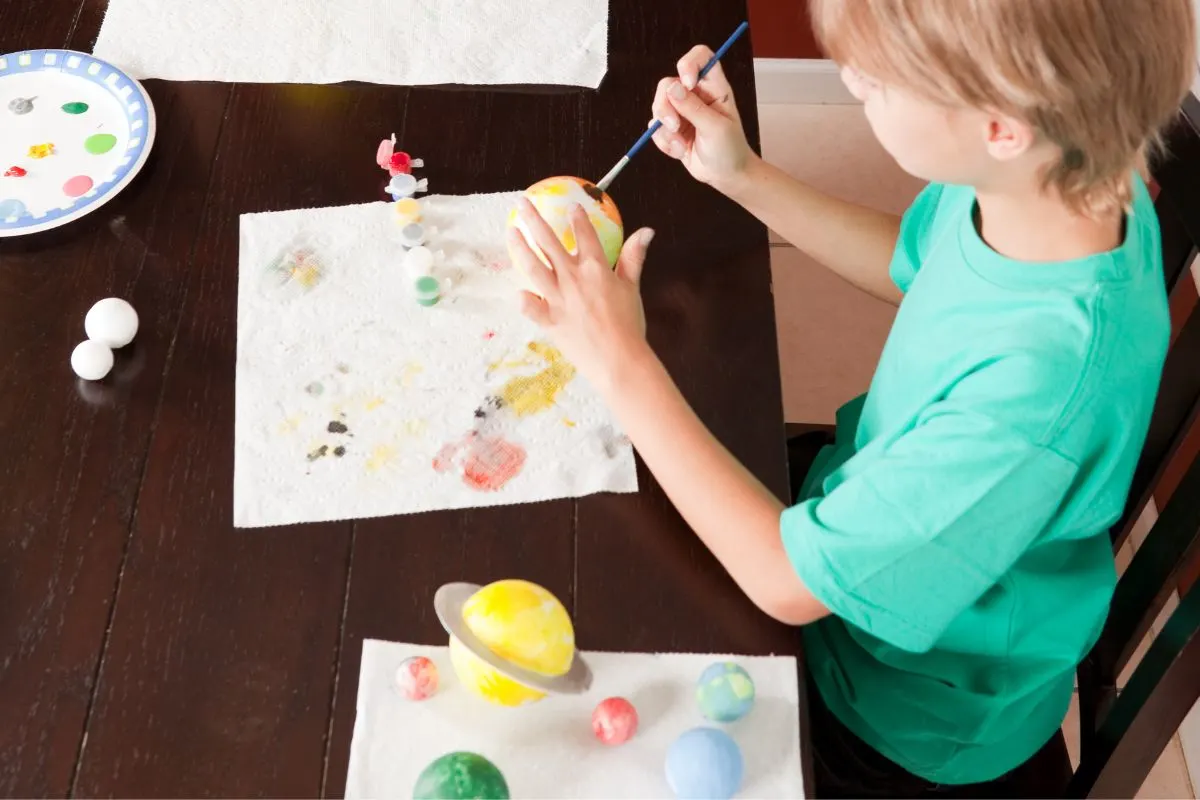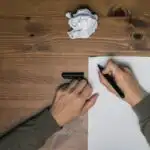Teaching young people about science can be an absolute joy, especially when it comes to teaching them about the solar system, and the amazing things that exist in the vast expanse above our planet.
The topic is naturally very engaging, and worth learning about.

The only problem is, children are naturally very restless, and they can find themselves growing bored very quickly, so you need to make sure that you use just the right tools to not only educate them but keep them engaged the entire time.
Luckily, if you want to teach your class about the solar system, without the kids getting bored, then you have come to the right place.
Today we are going to take a look at some of the very best solar system projects that you can implement in the classroom today, to engage young minds!
1. Water Color Solar System
This is one of the very best activities for teaching kids about the solar system because it is incredibly simple.
All you need to do is grab some watercolor paint palettes, some brushes, and plenty of paper for the kids to express themselves on.
Provide the children with some images of the solar system, and encourage them to choose colors that best represent each of the planets while also keeping the sizes consistent.
This will allow kids to memorize the solar system while also working on their fine motor skills, in order to color the planets within the lines!
2. Solar System Bottle Caps
This great project is perfect not only because it is educational, but it also encourages the children to recycle, and make use of things that might otherwise be thrown away!
Grab some bottle caps of various sizes, and encourage the children to decorate them in ways that represent each of the parts of the solar system.
Encourage them to consider the size of each part of the solar system, to choose the perfect layout.
This activity will allow the children to learn about the order of the solar system, and which planets are in closer proximity to others!
3. Popsicle Stick Solar System
The most important thing to learn about the solar system is the way that it is organized around the Sun, as the central part.
This activity, which uses paper cut-outs of the planets and the Sun, makes use of popsicle sticks to exaggerate the connection to the Sun that Earth and the other planets have.
You can either print out representations of the planets for the kids to use, or encourage them to paint and craft their own!
Also encourage them to cut the popsicle sticks to the appropriate length so that they represent the distance each planet has from the Sun!
4. Solar System Rocks
This can be a great activity for the young ones because it allows them to head outside and grab rocks that they can then paint to represent each of the planets.
Encourage the children to consider the size of each rock they paint, to have each rock represent the accurate size of each planet.
The kids will love the tactile nature of handling the rocks, and being allowed to get messy as they paint them!
5. Paper Mache Solar System
Paper mache is basically the ultimate elementary school craft. It allows the children to get really messy, as they create each of the planets, while also allowing them to create entirely 3D shapes that look awesome when put together.
You can either do this as one large class project, or encourage the children to work in groups to create the solar system together.
Once each of the planets has been made, attach them together in some kind of way, to create a striking display that can easily be shown off in the classroom!
6. Planet Hangers
If you want to encourage your children to create some simple solar system decorations that can be displayed in the classroom, or taken home at the end of the day, then this is the perfect project to try out!
All it involves is creating some kind of hanging structure, upon which you can then place a number of the planets, hanging from the bottom.
Encourage the kids to decorate the planets in all kinds of different ways, to create unique looks that they will love.
When the project is complete, you can easily then hang the completed solar systems from the ceiling of the classroom, or encourage the children to take them home and hang them up there!
7. Solar System Balloons
If you want a temporary and mess-free way to teach the kids about the solar system, and to learn the orders of the planets within the system, then using balloons can be a great solution.
All you need to do is to inflate a series of balloons of varying sizes and colors, and encourage the children to hang them from a wire in the correct order.
This is a perfect activity to do with larger groups, as they can work together to place all of the balloons into the correct place!
8. Pom-Pom Solar System
Creating pom-pom balls is one of the newer activities that has taken young children by storm.
This craft project will take a little more time, and you will need to grab some appropriate pom-pom materials and tools, so it makes for a perfect long-term project for the children to engage with.
Creating pom-poms is not actually too difficult, and following this guide, you can help your class to easily create bundles of soft planets!
We recommend setting the children into groups that will be responsible for creating solar systems together.
The children will love the soft feel of the pom-poms, and the satisfaction of creating them is highly engaging and tactile!
9. Fruit Solar Systems
This is an engaging activity that is not only educational but also provides the kids with an excellent snack to enjoy at the end!
Using some sliced fruit, you can easily represent a number of the different planets, and give the children a sense of how big the Sun is, and how small some of the planets appear by comparison.
This is a great way of helping children to consider the sheer size of the solar system!
We loved engaging in this project with the kids, because it kept their minds engaged, and also gave them a nutritious snack upon finishing!
10. Playdough Planets
The best thing about playdough is that it allows the children to create amazing 3D shapes, while also being mess-free and easy to put away at the end of the day.
Grab a bunch of playdough of different colors, and then encourage the children to create their own little planetoids that they can then organize into the correct structure of the solar system!
If you don’t have enough playdough for each child to use, simply pair the children up to create collaborative projects!
This is a great project if you want the kids to engage with the lesson without creating anything permanent, with materials that can be easily stored away.
11. Solar System Jars
This is a great project that allows the students to create a visual representation of the solar system that can easily be displayed in the classroom, so the kids can learn about the solar system whenever they want to!
It’s actually very easy to create these solar system jars, as all you need are some basic crafting materials and some wire.
Encourage the kids to create their own small planetoids, either with paper, clay, or any other suitable material, and then once the planets have been created, all you then need to do is attach them to the wire, and hang them within the jar, from the lid.
This deceptively-simple activity is perfect for creating amazing-looking solar systems that the children will love to just look at within the jar!
To Wrap Up
There you have it! Teaching children about the Solar System can be a great way to teach them about the sheer breadth of the wider universe, and really excite their imaginations.
Though there are all kinds of projects that you can get the kids involved with, to teach them about the solar system, these are easily the 11 best you will find!
Why not try one of these projects with your class? We made sure to select a varied range, with some projects being simpler than others, to give you plenty of choice!
- Homeschooling In High School: Pros And Cons - February 24, 2024
- How Do I Withdraw My Child From School To Homeschool? - February 23, 2024
- How To Not Go Crazy Homeschooling Kids: A Guide For Frazzled Parents - February 22, 2024









Leave a comment